SilverStone Fortress FT04 Case Review
by Dustin Sklavos on August 29, 2013 10:00 AM EST- Posted in
- Cases/Cooling/PSUs
- SilverStone
- ATX
The Fortress FT04 and Raven RV04 both inherit the concepts of their thermal design from SilverStone's incredibly popular and successful Temjin TJ08-E. That enclosure is a micro-ATX affair, but the principles that drive that case (and its excellent thermal performance) are present here. It's something that other vendors still seem to be struggling with: direct airflow over the hot components. Not this bottom-front to top-rear airflow, just a straight line. And thus, SilverStone does with two incredibly powerful 180mm fans what takes other vendors a lot more effort.
There's a tremendous amount of adjustability with both integrated fans; they can run whisper quiet at a low speed or as loudly and powerfully as a pair of Deltas, so much so that they were rattling the blinds in my room from five feet away after going through the case. Ordinarily I'd test at the lowest and highest settings, but I tried to modulate a middle setting as well. The reality is that you can easily adjust and get as little or as much performance as you want from these fans, so take the test results as a sort of starting point.
Ambient temperatures during testing hovered between 23C and 25C.
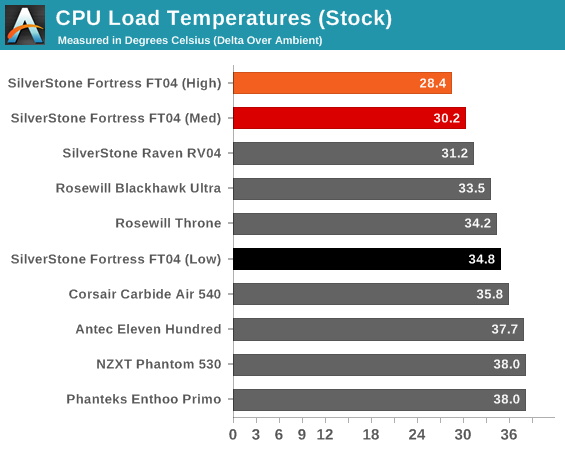
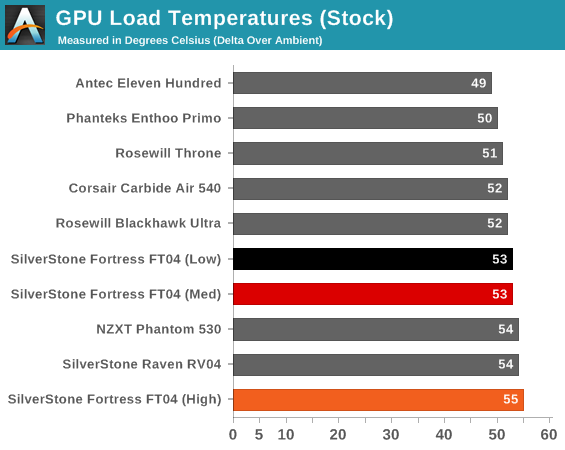
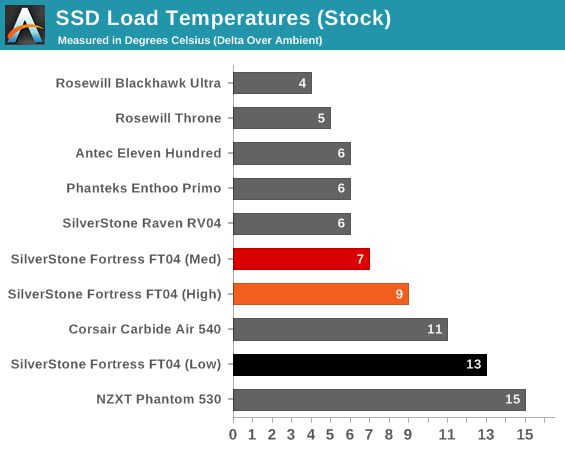
CPU performance is great, but one place where that diagonal airflow situation does seem to perform slightly better is with open-air graphics card coolers. The results on our GTX 560 Ti aren't awful, but they're merely competitive. Compare that to the CPU performance, which is basically bulletproof.
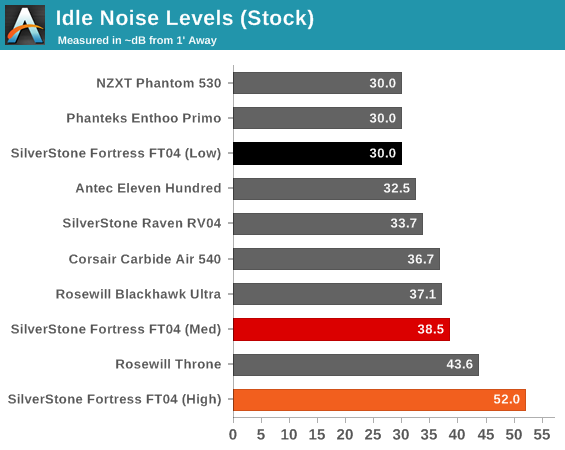
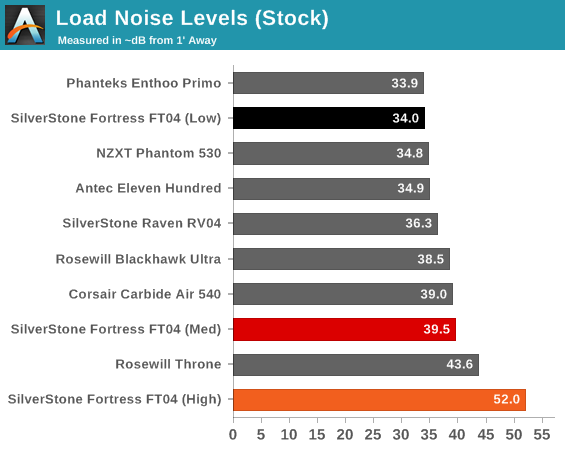
Noise levels are less than ideal, but remember, the minimum fan setting is really the worst case scenario. Look at how massive the gulf is between each fan setting.
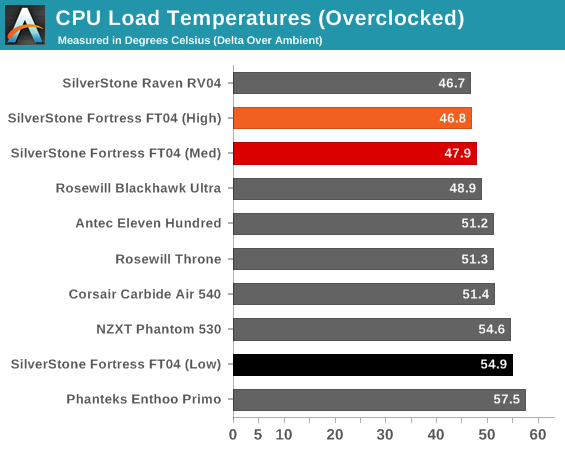

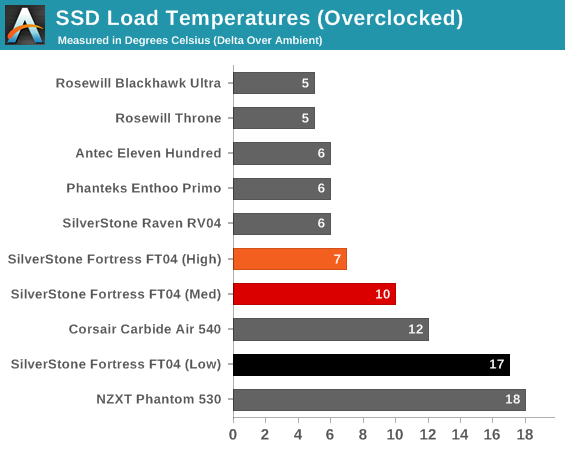
Overclocking is very kind to the FT04 on the CPU side, less so on the GPU. SilverStone even recommends blower style coolers for the FT04 and RV04 in the manual, and I wholeheartedly agree.
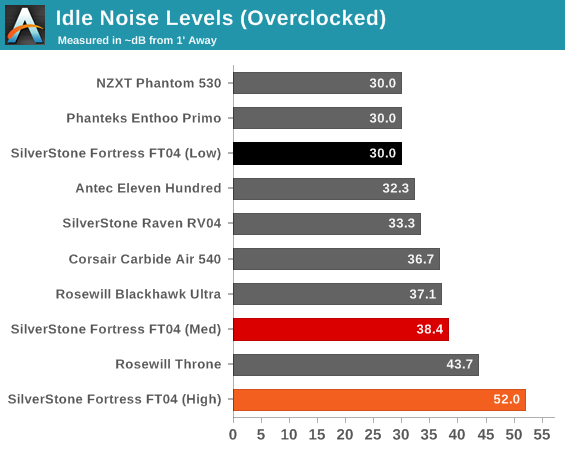
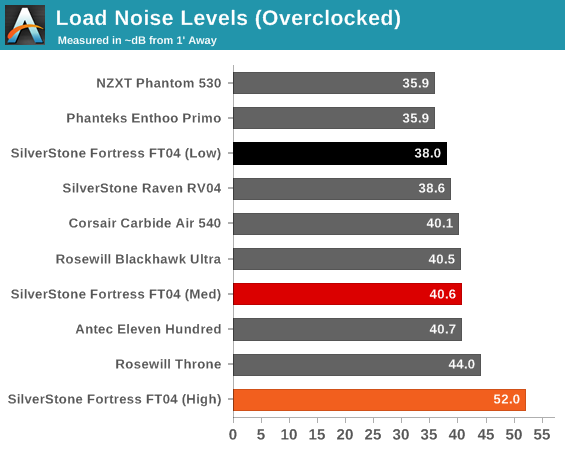
Noise levels are again tricky, with the FT04's highest fan setting basically cancelling out any internal noise. It would've taken some time and tuning to find an ideal fan setting for our testbed and again, it's going to depend on your build.
Finally, where the FT04 really shines is with the full fat testbed.
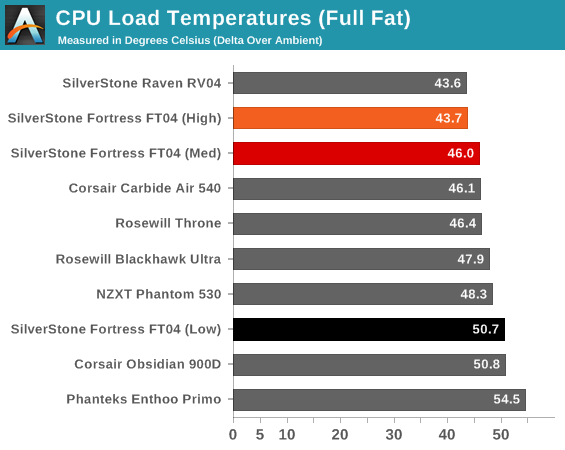
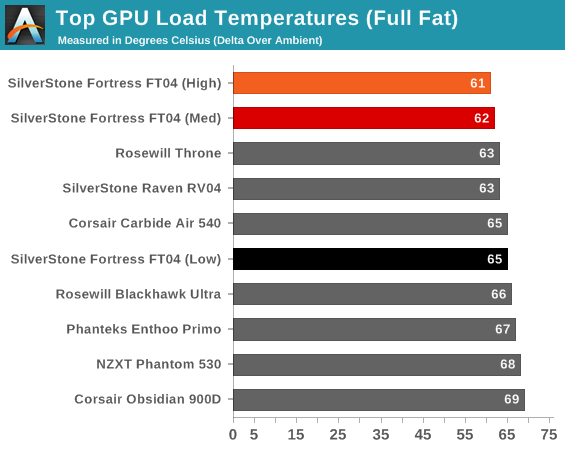
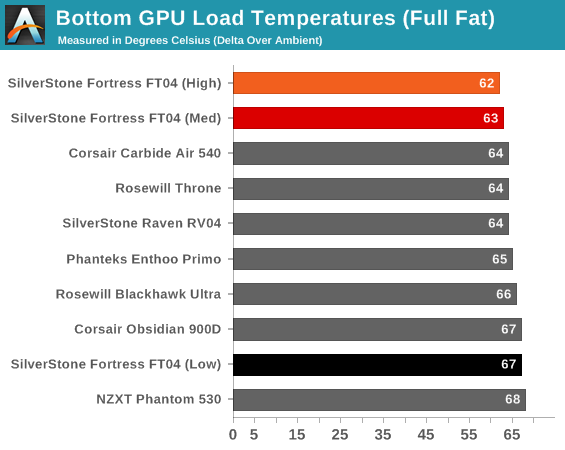
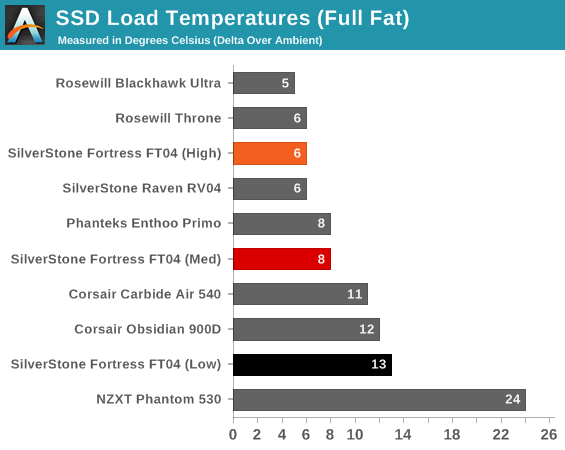
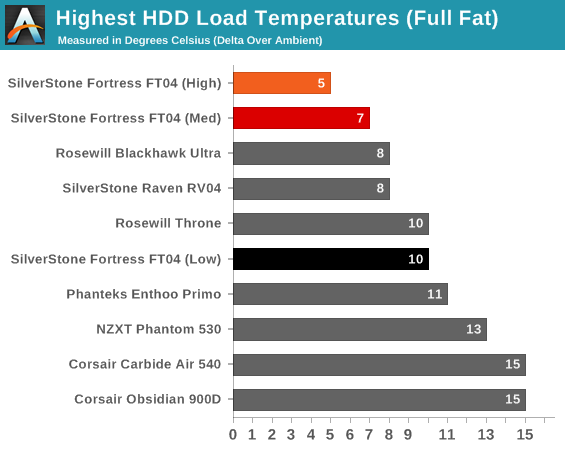
The blower-style coolers are exactly in the FT04's wheelhouse. This is the best possible scenario for this case and it, like the old FT02, is a borderline ideal enclosure for air-cooled multi-GPU systems.
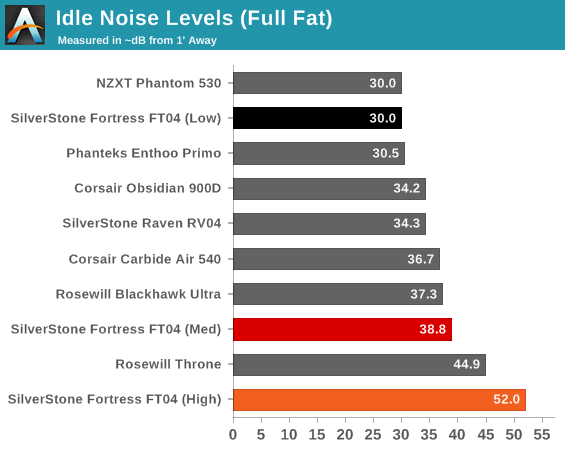
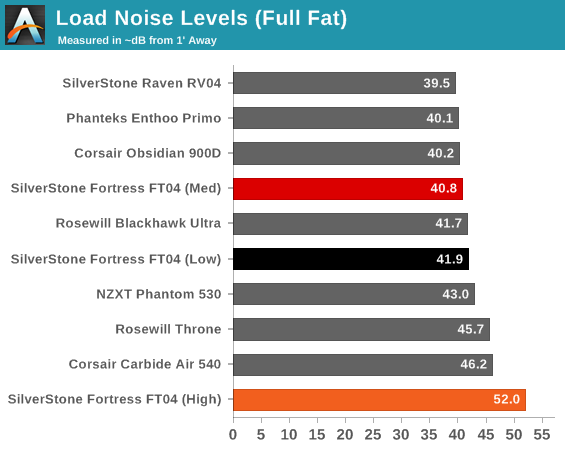
Once again, noise levels aren't excellent, but there's obviously wiggle room here. The FT04 is as powerful or as quiet as you need.










48 Comments
View All Comments
GokieKS - Thursday, August 29, 2013 - link
As someone whose primary desktop workstation is housed in an FT-03 Mini and whose gaming PC is in an FT-01, I sort of agree with you. I love both of them to death, but there are way too many quirks to building a system with the FT-03 Mini for it to be the best case ever made. All those components you listed? You *might* be able to stuff all of them into the case, but you will have to choose the components very carefully, and more likely than not make some slight modifications to the case to get it all to fit, and all the while probably cursing somebody (either SilverStone or yourself) because there is next to no chance you will get everything installed properly on the first try. Even my fairly simple (no dGPU, no ODD, H60i CLC, 1 SSD and 1 3.5" HDD) build required way more time, effort, and fiddling than any other computer I've ever built - and I've been doing it for 15 years.But will all that said, I wouldn't trade it for anything else - unless they update the mATX FT-03 to remove the plastic air vent which mars the otherwise beautiful design.
kkwst2 - Friday, August 30, 2013 - link
Yeah, I looked at the FT-03 and the Mini, but decided there were too many compromises. I settled on the tj08-e and have been extremely pleased. Took a bit more time and planning than a large case, but was able to get an SSD and 2 3.5 HDD in easily. Certainly not as distinctive as the FT03, but that's not really my thing. But I do appreciate the compact tj08.JDG1980 - Thursday, August 29, 2013 - link
First of all, thanks for doing this review - it was incredibly frustrating to have nothing written in English on the FT04 even a month after its public release.You mentioned the bottom of the front door snagging on carpets and your photo backdrop. Does this still take place if the case is on a smooth surface like a desk? Like many other users, I run my PC on a desk, so if it works OK there this isn't a deal-breaker.
I said this before on the RV04 review, but I think your mediocre performance on the single-GPU test was due to using an inappropriate graphics card. I understand you need a consistent test bed system, but the ASUS GeForce GTX 560 Ti DirectCU II TOP is about the worst card design possible for a direct airflow case: it has fins running perpendicular to the flow direction. Many newer DirectCU cards have the fins parallel to the long side of the card, and I suspect this would give substantially lower temperatures. An even better choice might be the Arctic Accelero S1 Plus aftermarket cooler; it has widely spaced fins which run the right way for direct airflow, and can be run fanless. I strongly suspect a FT04 or RV04 could handle a card with up to 150W TDP, maybe even more, using just the Accelero S1 Plus and the intake fans, with no dedicated GPU fan. I'll post again if I get a chance to test this. It's important to remember you are building a system, not just throwing together a collection of miscellaneous parts. There should be some synergy in your build.
Regarding the difficulty of assembly - I have a hard time really caring too much. I suspect this looms larger for testers than for actual enthusiasts, because testers have to build and unbuild all the time! If I get excellent thermals and acoustics, and the fit/finish/appearance is satisfactory, then I don't really care if I scrape a few knuckles during the build.
DanNeely - Thursday, August 29, 2013 - link
Ease of assembly is probably a lot more of a spectrum than an either or. While it's not a major concern for a box that I'll probably only swap GPUs and possibly SSDs over its 4 year life; given the choice between two cases with similar performance, pricing, and acceptable aesthetics I'll probably go for the one I don't swear at.For systems I build for friends/family not swearing at it while I'm working is a more important consideration. Boutique system builders probably put ease of assembly high on their list of criteria for picking a case.
And lastly, especially for higher end cases, there's an element of "if they screwed up one thing (ease of build), what other surprises am I going to run into later". For $200+ I expect the manufacturer to get everything right; when spending that much there really shouldn't be any compromises. Cheaper cases get more slack since on a budget system something has to give.
JDG1980 - Thursday, August 29, 2013 - link
I agree that such things are less forgivable at a $230 price point than at $110, but it seems to me that *all* cases involve compromises. I'm not sure there is such a thing as a perfect case on the market at *any* price. A case that's excellent for air-cooling (the FT02, for instance) will be only mediocre on water, and sometimes vice-versa. A massive full tower won't appeal to someone trying to build a compact system.RdVi - Friday, August 30, 2013 - link
Mine does not scrub the door on a flat surface.I agree that ease of assembly doesn't bother me a lot. Yes, it soured the process a little, but while I have a fair amount of experience, I have to concede that I'm just not good with fiddly things so most others interested in this case will probably find it easier than me. However, on the other end of the spectrum, I reworked the cabling once the build was complete due to buying a new PSU, turning the case on its side and then upright was somewhat of a challenge - it's heavy. Not that I struggled too much, but I did worry about not doing it right. And you had to hold the damn door shut every time you did.
As for the fit and finish, on my black model the only disappointment was the colour difference between the door and the top. I have to say that I don't really notice it so much now, and if you have the case on a desk, you won't see it when you're sitting anyway. It's not that bad, but I didn't expect there to be any difference between those two pieces. The plastic vents I expected to be different and luckily they actually look a bit better than I was bracing myself for, they don't stand out as being too different to the door or side panel to me.
arthur449 - Thursday, August 29, 2013 - link
I feel like, in the past, SilverStone has gone from a adapting a larger case to smaller cases (FT02 -> FT03), but in this situation they started with a smaller case (TJ08 / PS07) and tried to stretch it to a larger one.Ubercake - Thursday, August 29, 2013 - link
Even though I like a lot of things Silverstone does with their case designs, this seems to be a step back. An exhaust fan at the bottom? If not, the only exhaust appears to be through the top-mounted PSU hovering just above GPU2.I like the reverse design only when there are fans blowing up from the bottom like in other Silverstone cases.
JDG1980 - Thursday, August 29, 2013 - link
There is no bottom-mounted fan. I think the idea is that since the front fans have high static pressure, the hot air will be expelled out the vents in the back without needing an additional active cooler. But you could mount a 120mm fan on the back vent if you didn't trust that. Silverstone claims on their FAQ for this case that adding a 120mm fan increases CPU cooling performance, but actually makes the GPU run hotter. We don't know what they tested with, though.pdjblum - Thursday, August 29, 2013 - link
Just do not get why you refuse to list the materials in the specification table? It is nice to know if it is all aluminium, all steel, steel and aluminium, steel and plastic, and so on. It is not fun hunting around the prose trying to sort it out. I just don't get how the material is not a critical specification.